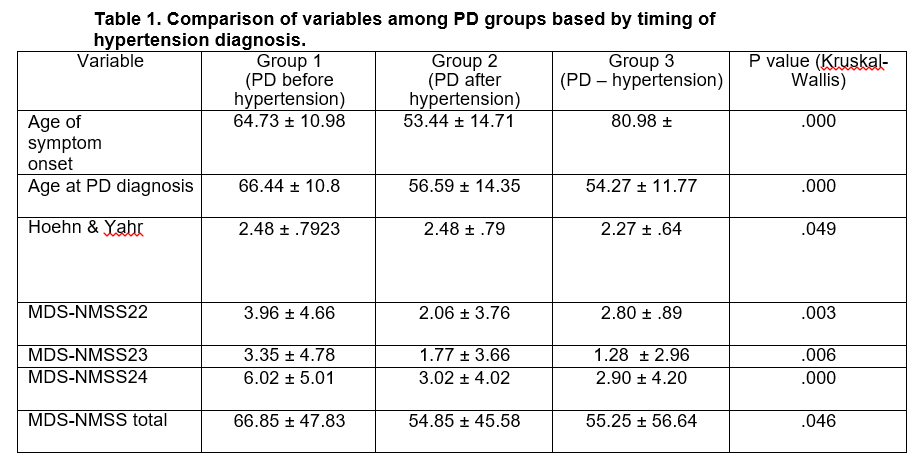Category: Parkinson's Disease: Non-Motor Symptoms
Objective: To investigate the correlation between hypertension and Parkinson’s disease (PD) diagnoses’ timing and clinical variables.
Background: Parkinson’s disease (PD) is a progressive neurodegenerative disorder characterized by bradykinesia, rigidity, and rest tremor. PD is identified by the presence of bradykinesia, with either rigidity, rest tremor, or both.1 As individuals age, hypertension prevalence rises2, often coexisting with PD. This co-occurrence could potentially affect the age of disease onset and lead to reciprocal influences at various stages.3
Method: In this study, PwPD were divided into 3 groups based on when they were diagnosed with hypertension relative to Parkinson’s disease diagnosis. Group 1 had PD before hypertension, Group 2 had hypertension before PD, and Group 3 did not have hypertension. We analyzed scores from MDS-UPDRS and NMS scales, as well as age of symptom onset and diagnosis. The Kruskal-Wallis test compared these variables among the three groups.
Results: 204 Mexican PwPD (52.2% males, 6.07±12.54 years old) of whom 64.0% had hypertension: 23.6% represented Group 2 and 41.4% Group 1. In the Kruskal-Wallis test, variables were analyzed pairwise, with ‘Pair A’ comparing Group 2-Group 1, ‘Pair B’ comparing Group 3-Group 2, and ‘Pair C’ comparing Group 3-Group 1. Variables demonstrating statistically significant differences included: 1) age of symptom onset (p=.000), significant for Pair A and C with p=.000; 2) age at PD diagnosis (p=.000) for Pair A and B with p=.000; 3) Hoehn and Yahr stage with p=.049 for Pair B; 4) NMS22 (p=.003) with p=.019 for Pair B and p=.010 for Pair C; 5) NMSS23 (p=.006), for Pair A with p=.044 and for Pair C with p=.012; and 6) NMS24 (p=.000), for Pair A with p=.001 and for Pair C with p=.000. (Table 1)
Conclusion: Based on the findings of this study, we observed significant associations between the timing of hypertension diagnosis and various clinical factors in PwPD. These findings imply that the timing of hypertension diagnosis relative to PD diagnosis could impact symptom onset age, diagnosis age, and disease severity, as indicated by Hoehn and Yahr stage and non-motor symptom scales. However, further extensive research is required to better understand changes in disease progression and severity in patients with both hypertension and PD, as well as those without this comorbidity.
Table 1
References: 1. Bloem BR, Okun MS, Klein C. Parkinson’s disease. Lancet. 2021 Jun 12;397(10291):2284-2303. doi: 10.1016/S0140-6736(21)00218-X. Epub 2021 Apr 10. PMID: 33848468.
2. Katsi V, Papakonstantinou I, Solomou E, Antonopoulos AS, Vlachopoulos C, Tsioufis K. Management of Hypertension and Blood Pressure Dysregulation in Patients with Parkinson’s Disease-a Systematic Review. Curr Hypertens Rep. 2021 May 7;23(5):26. doi: 10.1007/s11906-021-01146-5. PMID: 33961147.
3. Tulbă D, Avasilichioaiei M, Dima N, Crăciun L, Bălănescu P, Buzea A, Băicuș C, Popescu BO. Shared Molecular Targets in Parkinson’s Disease and Arterial Hypertension: A Systematic Review. Biomedicines. 2022 Mar 11;10(3):653. doi: 10.3390/biomedicines10030653. PMID: 35327454; PMCID: PMC8945026.
To cite this abstract in AMA style:
WF. Moguel Cardín, AL. Guerra Anzaldo, GA. Espinosa Cruz, A. Adam Castro, A. Dominguez García, A. Cervantes Arriaga, M. Rodríguez Violante, AJ. Hernández Medrano, G. Rivera Monroy, K. Velázquez Román, RJ. Baños Betancourt, CF. álvarez Hernández, DP. Romero Terán, JC. Delgado Uriarte, NP. Moreno Aldama, MC. Unda Mcfarlane, A. Uribe León. Association Between Hypertension Timing and Clinical Variables in Parkinson’s Disease: A Retrospective Analysis [abstract]. Mov Disord. 2024; 39 (suppl 1). https://www.mdsabstracts.org/abstract/association-between-hypertension-timing-and-clinical-variables-in-parkinsons-disease-a-retrospective-analysis/. Accessed December 25, 2025.« Back to 2024 International Congress
MDS Abstracts - https://www.mdsabstracts.org/abstract/association-between-hypertension-timing-and-clinical-variables-in-parkinsons-disease-a-retrospective-analysis/

